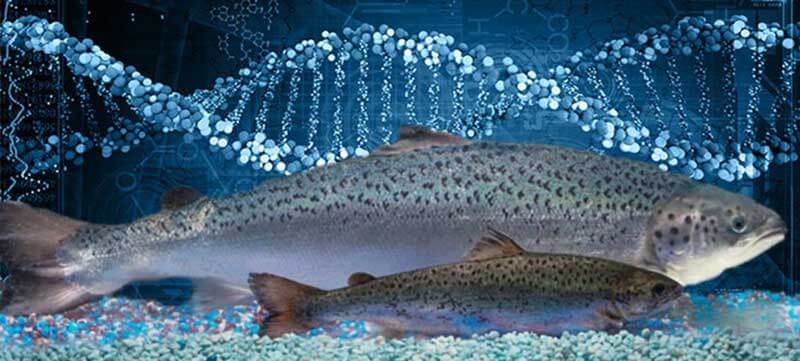- Genetically modified animal products enter grocery stores
- You may have already tasted transgenic salmon – without knowing it was GM
- Ordering food from the GM side of the menu
- Regulations can’t be one-size-fits-all when it comes to our food
Being able to alter the genomes of living organisms has been an active quest for scientists for decades. To do this, they’ve been refining the techniques of inserting DNA from a ‘donor’ organism into the DNA of a ‘host’ animal, creating an organism with unique characteristics. But if you think that genetic modification is something new in the world of science – it really isn’t. The first successful experiment was conducted nearly 50 years ago. In 1974, Rudolf Jaenisch, a professor of biology at MIT, together with Beatrice Mintz, a renowned embryologist, managed to modify the genetic makeup of mice to study ‘the plagues of the 21st century’ – cancer and neurological diseases. But that was just the beginning.
Many claim that tweaking the DNA of an organism is not equal to playing with Mother Nature, as the cause is much nobler than many believe. Let’s take the biotech company SAB Biotherapeutic as an example. It managed to genetically modify cows to produce human antibodies – proteins that fight viruses. These cows will be used as blood donors for people suffering from various diseases, including influenza and Ebola. Companies like this one show that genetic modification isn’t necessarily something to be afraid of, but something we should possibly embrace. And it isn’t reserved to medical applications, as genetically modified (GM) food might soon become commonplace in our markets. In fact, that’s already happening.
Genetically modified animal products enter grocery stores
We can all agree that food labelled ‘GM’ is almost repellent in an era of increased concern about diet and healthy food. And people have a right to know what they’re eating. Discussions related to genetically modified food, including both plants and animals, always leave a lingering feeling of distrust and worry in the air, long after the topic is closed. But many claim this is irrational fear. According to a report from the US National Academies of Sciences, Engineering, and Medicine, genetically modified food poses no threat to human health. That’s pretty good news, especially if you live in Canada – the first country in the world to allow imports of genetically modified fish.

You may have already tasted transgenic salmon – without knowing it was GM
Canadian supermarkets have become the first to start selling genetically modified salmon. Developed by a team of scientists at Newfoundland’s Memorial University in Canada, and sold by the US-based AquaBounty Technologies, the salmon can grow much faster, reaching adult size in only 18 months (compared to 30 months for conventionally-farmed Atlantic salmon). What’s more, they require 25 per cent less food and decrease carbon emissions by up to 25 per cent. So, the fish grows twice as fast, doesn’t need as much food, and is eco-friendly – that sounds too good to be true, right? Maybe. Environmentalists are concerned that transgenic salmon could somehow ‘contaminate’ the wild salmon population if they ever reach it, but scientists thought of that, too. They made sure the modified fish are sterile and raised in tanks, so they don’t pose any real threat.
Even though scientists have demonstrated that genetically modified salmon is safe to eat, many still worry. In fact, Thibault Rehn, from the group Vigilance OGM, goes as far as calling Canadian consumers “the first guinea pigs”. But officials claim that they spent four years testing to be sure that transgenic salmon is safe and nutritious, and they argue that no special labelling is necessary as a result. Ron Stotish, the chief executive of AquaBounty, says that Rehn’s concerns are unfounded. He notes that rather than worrying about nothing, “the larger market is viewing it as a more predictable, sustainable source of salmon” and that the sales figures are encouraging.
But, salmon isn’t the only genetically modified food that has arrived at our supermarkets. Behold – transgenic pork.
Ordering food from the GM side of the menu
The two litters of pink, squealing piglets kept in a research facility at the University of Missouri look and sound no different than any other pigs on any other farm. But, there’s nothing ordinary about them. In simple words – they have undergone a genetic makeover. But this wasn’t done because someone would like to play Dr Frankenstein. The research teams from the University of Missouri and the Kansas State University made a new breed of pigs resistant to a disease that plagues swine. This new breed is immune to Porcine Reproductive and Respiratory Syndrome (PRRS), a plague that spreads through pig populations like wildfire, leaving hog farmers with only the most painful option – euthanisation. According to lead researcher professor Alan Archibald, there’s no need to feel uncomfortable about eating genetically modified pork. He assures us that “In terms of the changes we have made, we have removed a very small piece of the egg genes. We haven’t added anything that wasn’t there in the first place, so consumers have nothing to worry about in that sense.” So, bon appetite!
Regulations can’t be one-size-fits-all when it comes to our food
It’s completely understandable that people are sceptical of genetically modified food that they might soon find in supermarkets. Even Kevin Wells, an assistant professor at the University of Missouri, who worked with the PRRS-resistant pigs and sat on the federal advisory committee on the AquaBounty salmon, said that it’s totally legitimate to pose questions such as whether “a brand-new protein” in GM animals could cause allergies in humans. And while transgenic animals might mitigate world hunger and make animals resistant to deadly diseases, we might still need more testing. But, sooner than many would expect, transgenic meat will be regarded the same as the ‘non-enhanced’ version.
Share via:


